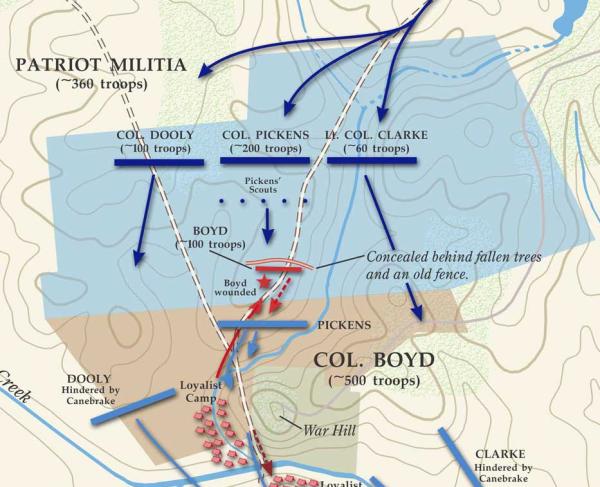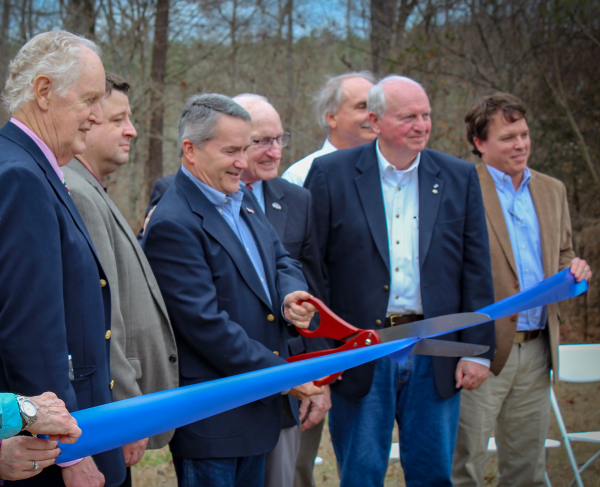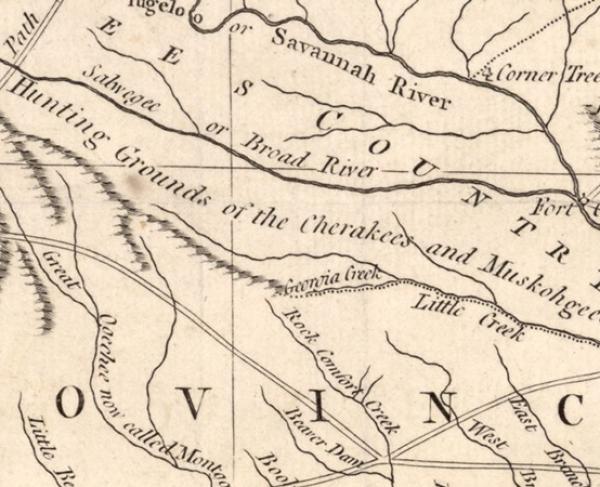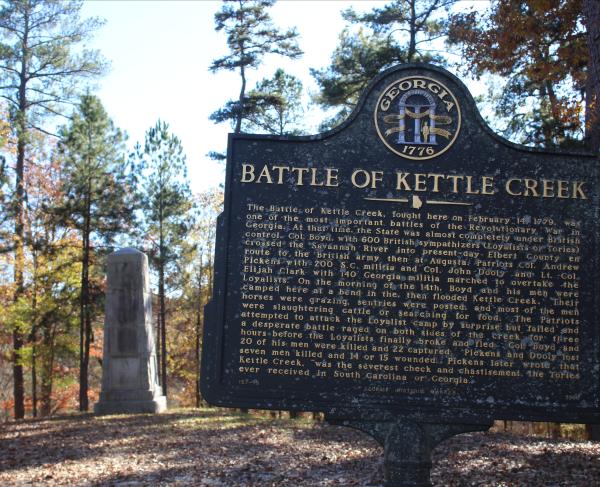
Kettle Creek Battlefield, Wilkes County, Ga.
For more than 240 years, slain Patriot and British soldiers lay in unmarked, makeshift, shallow graves in the backcountry of Georgia—all but forgotten casualties of a battle all but overlooked. That is, until the spring of 2015, when 24 trained cadaver dogs went to work on the Kettle Creek Battlefield near Washington, Georgia. Today — on the strength of their sniffing, plus collaborative work between the American Battlefield Trust, local partners and elected officials — the far-larger parkland is an officially affiliated site of the National Park System.
While the British met initial success during the 1776 New York Campaign and Philadelphia Campaign of 1777, the stunning loss at Saratoga that engendered the alliance between the Americans and French forced the British to reconsider their strategy. Pivoting to the south in hopes of subduing the Revolution below the Mason-Dixon Line, the British intended to pacify the colonies of Georgia, Virginia and the Carolinas by separating them from the rebellion in the middle and northern colonies. And after the British took Savannah on December 29, 1778, fear spread among Patriot colonists that red coats would begin to win favor in the rural areas of the southern colonies, persuading loyalist sympathizers to become active participants in the war.
On Cupid’s Day, 1779, those fears were quelled with the overwhelming victory of Patriot forces at Kettle Creek.
As British Colonel John Boyd set out through the Georgian woods with his newly raised regiment of 800 Tories, his ultimate destination was Augusta, which had just been successfully captured by British General Archibald Campbell. After suffering nearly 100 casualties during their march south due to Patriot partisans, Boyd ordered his men to rest and make camp on the north side of Kettle Creek in Wilkes County. He was unaware that 350 Patriots, under the overall command of Colonel Andrew Pickens, were preparing to strike.
The ensuing melee lasted four hours and, despite outnumbering the Patriots roughly two-to-one and commanding the higher ground, the surviving Tories began to break and run — abandoning horses and supplies as they fled across the creek. Suffering 115 casualties in the battle, in addition to the 100 lost on the way to Kettle Creek, the once 800-strong Tory regiment was left with fewer than 600 battered and beleaguered men.
Controversially, approximately 50 loyalist prisoners were subsequently refused prisoner of war status and convicted of treason at the behest of Patriot General Andrew Williamson. He wrote:
“Our eyes are now opened and not with standing the lenity hitherto shown them they have at this crisis given convincing proofs, and that no faith should or ought be placed in their most solumn assurance and a severe example must certainly be made for the benefit of the State, and as a terror to others.”
Of the 50 prisoners captured, 20 were sentenced to death, although only five were ultimately hanged.
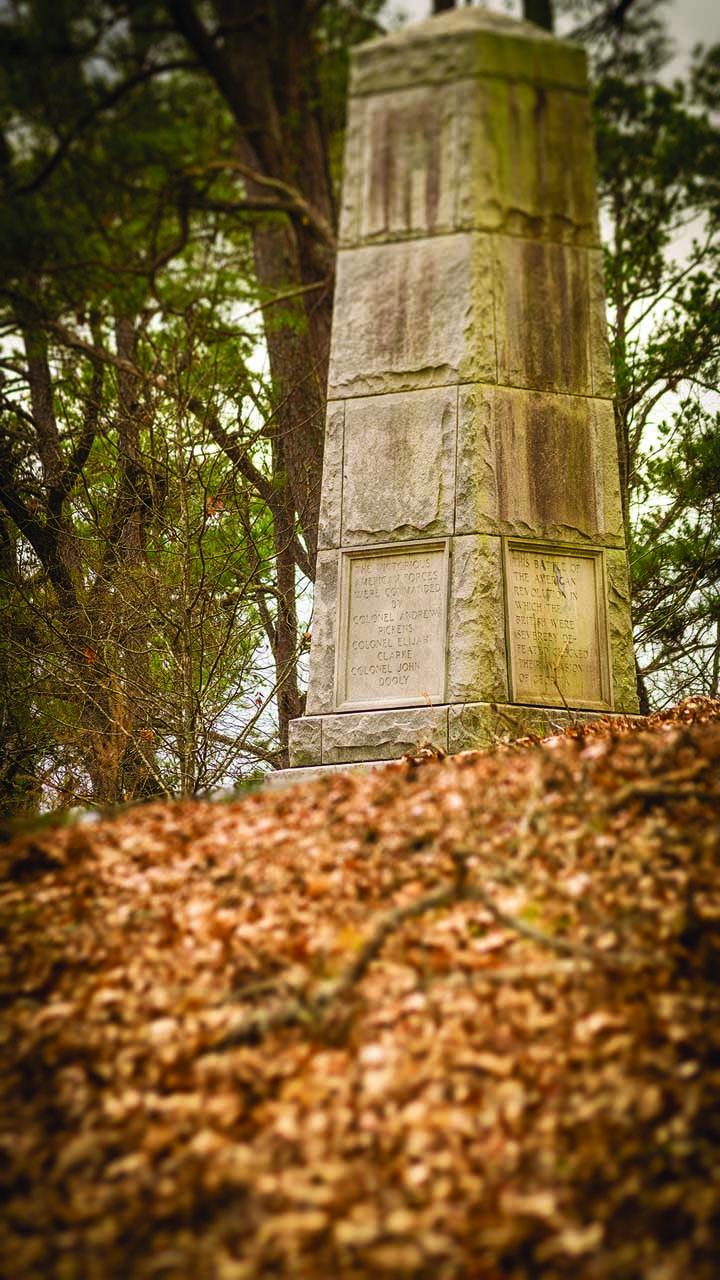
While the general location of the battle was long widely accepted — the Daughters of the American Revolution acquired a property in 1900 and the U.S. War Department erected a monument in 1930, plus a 1975 listing on the National Register of Historic Places — the first systematic archaeological search wasn’t conducted until 2008, an astounding 229 years after the battle’s final salvo. The Kettle Creek Battlefield Association formed in 2011 and purchased a significant 60-acre tract two years later.
Still, Kettle Creek garnered little attention and few headlines. Then came the innovative use of cadaver dogs, a new approach to archaeological fieldwork. According to the project’s official report, Dan Bigman of Bigman Geophysical LLC was brought onto the battlefield to “direct a remote sensing survey that consisted of using human remains detecting [HRD] dogs.” K9 Search & Rescue Specialists, Inc., surveyed three key areas of the battlefield and located 10 locations of possible human remains scent — alerting to locations and geophysical and soil anomalies that suggested individual burials.

While the report notes that the dogs “found no clear, indisputable evidence of burials at any of the five targets. That is, no human remains, personal artifacts, bullets, or grave shafts were revealed”; it also states that the archaeologists “believe that it is more likely than not that the shallow, poorly defined depression that contained a greater-than-normal amount of rock in Priority Target 7 was a Revolutionary War field burial.” A May 2018 lab result supported these findings, with human mitochondrial DNA extracted from four out of six target zones.
In 2017, Kettle Creek was one of just 32 battlefield sites across the country to receive a federal matching grant for additional land protection. That grant, with subsequent contributions from the Trust and the Watson-Brown Foundation, plus the outstanding stewardship and advocacy of the Kettle Creek Battlefield Association, allowed for the expansion of the park’s borders, adding 180 acres, including the area with the newly identified graves.
“It’s a place that needs to be recognized. Very few people know about it,” said Vince Dooley, famed University of Georgia football coach and ardent battlefield preservationist at the 2018 event celebrating the success. “Preserving the battlefield is like a laboratory classroom, particularly as to our history in Georgia.”

Efforts to steward, interpret and improve the Kettle Creek Battlefield have continued. In January 2021, then U.S. Rep. Jody Hice announced it had been officially named an affiliated site of the National Park System. In 2024, the Georgia Outdoor Stewardship Trust issued a $1.4-million grant to acquire additional land; this will be administered by Wilkes County, which is expected to add another $500,000 in in-kind services and stewardship.
Related Battles
21
115
